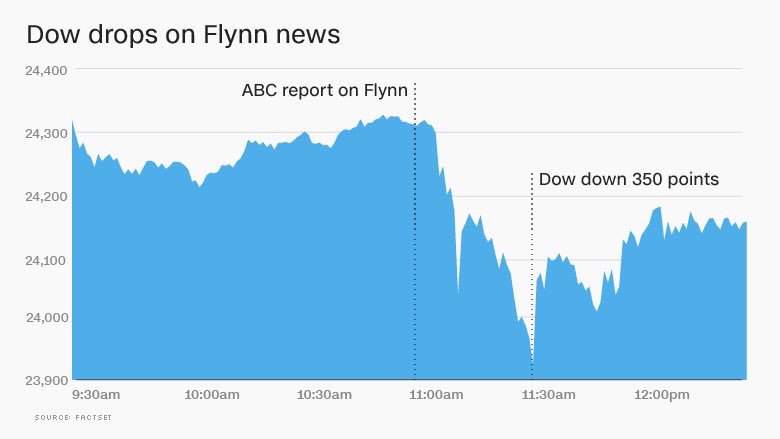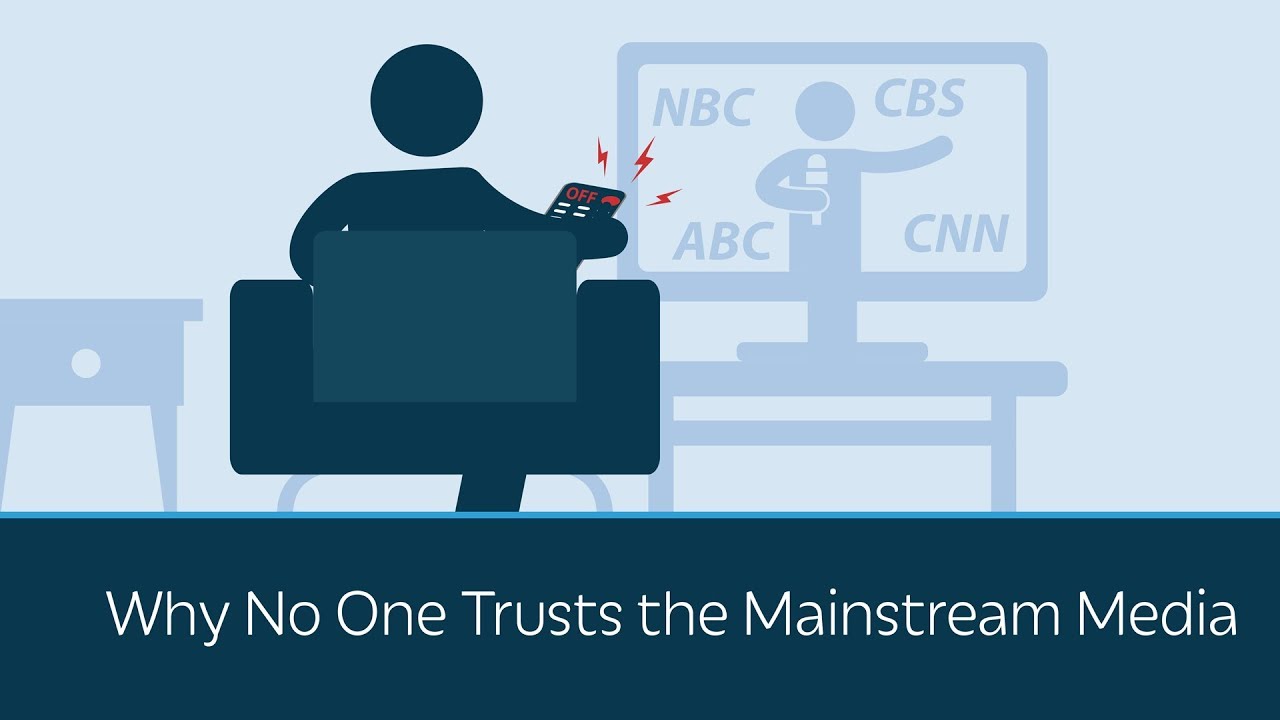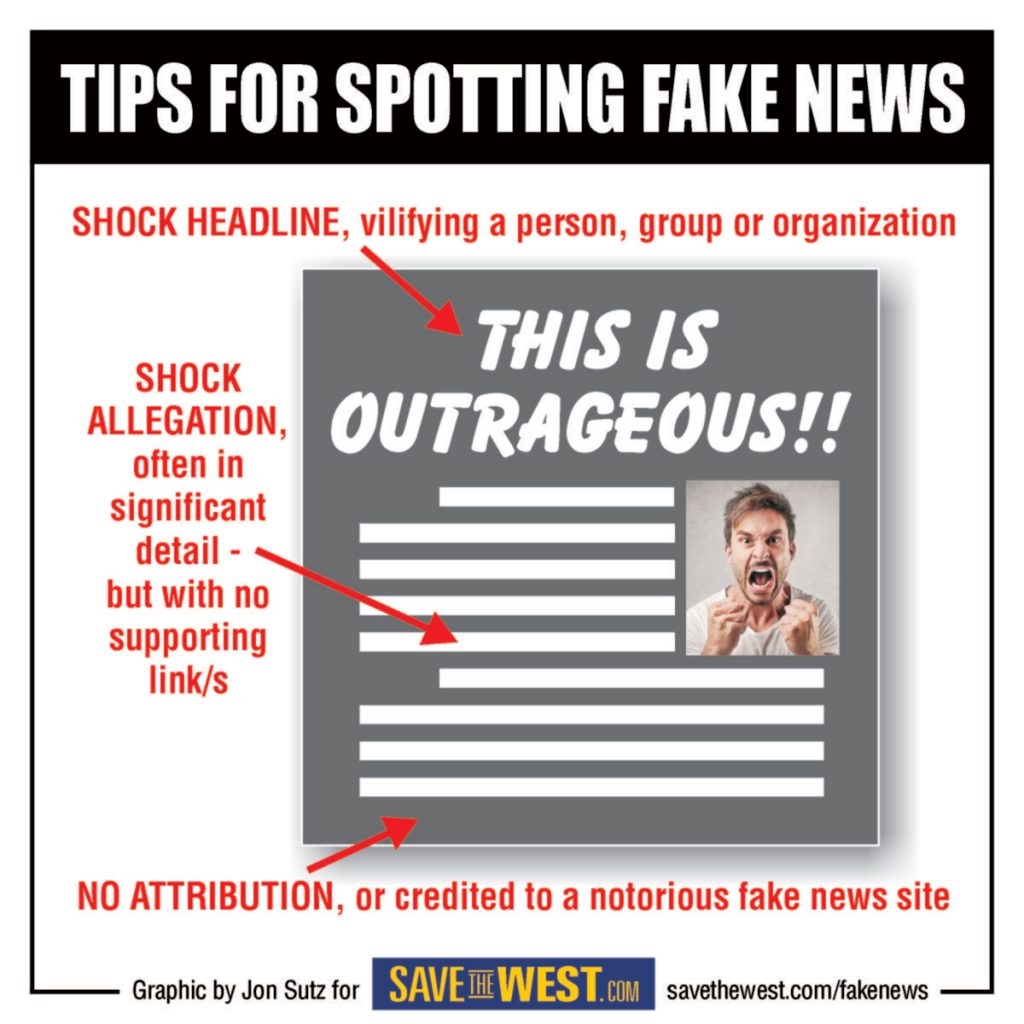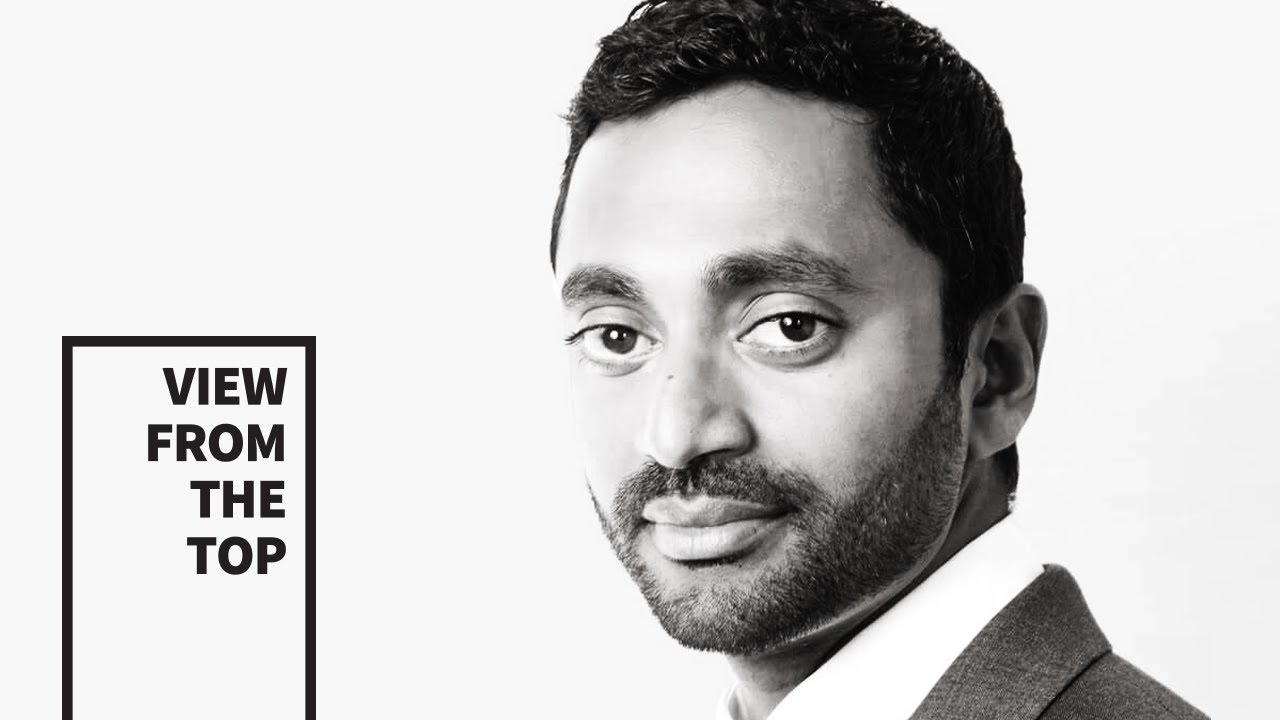.
Title: Fake news: What it is, tips for spotting it, and how to stop its spread
By Jon Sutz, Editor, SaveTheWest.com
The term “fake news” burst into the public lexicon in 2016. But what is fake news? Who creates it, and why? How can we detect it? And how can we help to stop its metastasis?
This special SaveTheWest report was created to begin answering these questions.
As we’ll see, in many cases the answers are neither simple nor conclusive. Our mission here is to set the framework for a constructive discussion about these issues, so that our public dialogue may become more reality-based, civil, and constructive.
Contents
(1) Introduction: What is fake news?
(2) Who creates fake news, and why?
(a) Domestic organizations and individuals
(b) External Anti-American governments and government-sponsored organizations
(3) How can you identify fake news?
(4) Slide show: Examples of fake news
(5) How can you help to stop the spread of fake news?
(a) Socrates’s “Test Of Three”
(b) A personal commitment of principles
(6) Articles & reports regarding fake news
(1) Introduction: What is fake news?
Wikipedia has an excellent definition, history and analysis of “fake news” here.
We define “fake news” as:
A written, graphic, audio or video work product (“item”) that is deliberately designed to look like genuine news items, or a summary thereof (such as a meme), but which instead is based on an allegation or data about an important issue, person or group, that its creator(s) know or should know is untrue, or grossly decontextualized.
The key factor defining fake news, with limited exceptions*, is the malicious intent of the person or organization that creates and spreads it. (*One exception being when the head of state or an influential organization shares an item of fake news into the social media ecosystem, without validating its accuracy, for which he or she then bears full responsibility.)
The difference between fake news and false news
Fake news, however, is different from false news, which we define as:
An item that is published by major self-proclaimed “news” organization, because the person(s) responsible for producing it assumed that the source material was correct, but they did not perform the due diligence to confirm it — and which the organization later retracts, or corrects.
A recent example of false news occurred on December 1, 2017, when ABC News “senior investigative journalist” Brian Ross falsely reported that in exchange for a reduced sentence, former Trump adviser Gen. Michael Flynn agreed to testify that while a presidential candidate, Donald Trump instructed him to reach out to Russian government operatives. This shock report, suggesting that Trump acted grossly inappropriately and possibly illegally while a candidate, caused the NY Stock Exchange to plunge 350 points within minutes.
 In reality, as ABC admitted later in the day, it was only after Trump became president-elect that he instructed Gen. Flynn to conduct this outreach. This is a routine occurrence for incoming administrations to establish contact with foreign governments, during the transition preparation process. Soon after, ABC suspended Ross for four weeks, and announced it would not allow him to do any further reporting on White House issues.
In reality, as ABC admitted later in the day, it was only after Trump became president-elect that he instructed Gen. Flynn to conduct this outreach. This is a routine occurrence for incoming administrations to establish contact with foreign governments, during the transition preparation process. Soon after, ABC suspended Ross for four weeks, and announced it would not allow him to do any further reporting on White House issues.
There is no way anyone could have known, until ABC reported its correction, that Ross’s story was false.
Running an item because one believes it to be true, then discovering it is not (as in this recent ABC News debacle, documented in Section 3), and correcting it, is not the same thing as creating and sharing something that one knows, or should know, is fake, or cannot be substantiated.
A brief history of fake news
Until the advent of social media, fake news distribution was generally limited to tabloids at supermarket checkout aisles, and conspiracy theory publications:
In the last ten years, however, however, anyone with a computer or smartphone can create the most outlandish fake news imaginable, and instantly distribute it worldwide through Facebook, Twitter and other social media channels. And, if it is based on a professionally-designed website, such as from a free WordPress template, they can even make considerable money doing so.
Regardless of its form or the identity of its creator, the purpose of fake news is to deliberately trick people into believing falsehoods. And in an age in which 50% of Americans between ages 18-50 (35% of 18-29 year olds) say social media is their “most helpful type of news source,” the metastasis of fake news bears chilling implications for our ability to have discussions, and form perceptions, that are based on reality.
(2) Who creates fake news, and why?
There are two answers to this question. The first answer is fairly straightforward. The second answer is more complex, but is vital for Americans’ understanding of what is happening to us, who is doing it, and why:
(2a) Domestic organizations and individuals:
♦ News entities
♦ Political organizations
♦ Independent muckrakers
♦ Clickbait fraudsters
(2b) External Anti-American governments and government-sponsored organizations
(2a) Domestic organizations and individuals
Domestic news entities
According to Gallup, Americans’ trust in news organizations has reached an all-time low point. Journalists, particularly TV journalists, are among the least-trusted occupations in America. Nearly two-thirds of Americans, from across the political spectrum, believe the mainstream media publishes fake news. The reasons are many, as documented by numerous analysts:
ABC’s Fake News Tanked the Market Yesterday, by Timothy Meads, TownHall.com, December 2, 2017. [Update: ABC’s Brian Ross suspended for erroneous report on Flynn plea deal, BBC.com, December 3, 2017.]
Viral Fake News Screenshot Montage, by Robert Kraychik, Daily Wire, June 15, 2017.
Mika Brzezinski: Media’s Job Is to ‘Control Exactly What People Think’, by Chandler Gill, Washington Free Beacon, February 22, 2017.
MTV News reporter admits joining Trump protests, by Kyle Olson, The American Mirror, February 21, 2017.
American journalism is collapsing before our eyes, by Michael Goodwin, NY Post, August 21, 2016.
In this short video, legendary investigative journalist Sharyl Attkisson presents several examples of fake news, ranging from deliberately crafted items, to egregious double-standards, to what she terms “transactional journalism”:
Motivations: In general, journalists’ bias and willingness to create fake news is motivated by a desire to advance an unspoken political agenda. The following facts indicate the dominant agendas that most journalists are seeking to advance:
- 97% of monetary donations from mainstream journalists go to left-wing political candidates and organizations, which present clear conflicts of interests
- Only 7% of journalists identify as Republicans
Domestic political organizations
The phenomenon of political organizations producing fake news stretches back to the first experiments in representative democracy, and have been part of political information ecosystems ever since.
Their motivations are purely self-serving: to score momentary political points against their opponents’ beliefs, policies, candidates and records, by spreading lies or egregiously distorted information.
Domestic independent muckrakers
With the advent of the Internet, blogging, and particularly social media media, anyone can be a “news” publisher. And with WordPress, anyone with minimal data processing skills can obtain a turn-key website template for free, or very low cost, that to the untrained eye often rivals those of major news sites. Further, within a few minutes, anyone can create a meme — a graphic image that is optimized for use in social media.
Notice that in all these cases, one can create content that looks professional, but may in fact be fake news, created by muckrakers who are devoid of character and any type of accountability.
Alone, their wares will have no effect, because they will not enter our information ecosystem. In our hyper-politicized, balkanized political culture, however, fellow travelers who won’t devote the time to check out these memes, but find them compelling, may share them with hundreds or thousands of followers. Or, in the case of President Trump and Hollywood celebrities, millions of followers. More on that in a moment.
(2b) External Anti-American governments and government-sponsored organizations
Background: For 46 years, from 1945-1991, America was engaged in a non-military conflict against the Union of Soviet Socialist Republics (USSR), a network of totalitarian communist nations, run out of Russia. Unlike America, with our freedom of speech and the press, and borders to keep unauthorized people out, the USSR had no free speech or free press, and constructed borders to keep its people inside, and enslaved. Thus, the only information that people within the USSR had access to was that which the government created or authorized.
While America could not infiltrate the public dialogue in the USSR, the KGB, its version of our CIA, set up elaborate networks of operatives in America and Western Europe, to wage what it termed “cultural warfare.” Specifically, they infiltrated three primary targets: our news organizations, educational institutions and entertainment media.
Motivation: The primary motivation of the KGB and its cultural subversion programs against America were multi-faceted:
- To pit various interest groups against each other, based on lies
- To undermine our ability to have civil, fact-based discussions
- To cause general cynicism
- To eat away at our trust in our major governmental, civic and business institutions
 All of these facts were well known within U.S. intelligence community, and verified when the USSR imploded in 1991, and for the first time, Western analysts had access to the vast records of the KGB and its allied agencies. The American public, however, was made aware of this xxx
All of these facts were well known within U.S. intelligence community, and verified when the USSR imploded in 1991, and for the first time, Western analysts had access to the vast records of the KGB and its allied agencies. The American public, however, was made aware of this xxx
Yuri Bezmenov a KGB propaganda master who defected to the West, communist operatives expected to be thrown out of U.S. classrooms, newsrooms and other major institutions. Instead, they were welcomed with open arms. In 1984, Bezmenov warned us that to begin undoing the damage that he and the KGB did to America, through cultural subversion:
“You’ll need 15 or 20 years to educate a new generation of patriotically-minded and common-sense people.”
We didn’t listen. See videos of Bezmenov lectures here, and his monograph about his defection, what he helped do to us, and how we can begin to undo it, “Love Letter to America,” here. Below is an excerpt from his 1984 interview (see the full video here):
Russian disinformation campaigns continue to this day, as was recently discovered in regards to Ukranian dissent over its leadership:
Inside a Russian disinformation campaign in Ukraine in 2014, by Ellen Nakashima, Washington Post, December 25, 2017.
And in regards to the 2016 U.S. presidential election, while investigations are ongoing as to the nature and extent of Russian efforts to create and spread fake news, here are some reports that appear to be credible:
Here’s what fake Russian Facebook posts during the election looked like, by Rob Tornoe, Philly.com, October 6, 2017.
Russia hired 1,000 people to create anti-Clinton ‘fake news’ in key US states during election, Trump-Russia hearings leader reveals; Senate Intelligence Committee’s Mark Warner claims the Kremlin targeted pivotal swing states, by Rachel Roberts, The Independent (UK), March 30, 2017.
(3) How can you identify fake news?
As described in Section 1, there is a difference between fake news and false news.
No one can identify false news until it’s discovered for what it is.
There is nothing you can do to detect news items that are partly or completely untrue, after they are published by major organizations, until after they’ve been proven as such. A recent example: on December 1, 2017, ABC News “senior investigative journalist” Brian Ross falsely reported that in exchange for a reduced sentence, former Trump adviser Michael Flynn agreed to testify that while a presidential candidate, Donald Trump instructed him to reach out to Russian government operatives. This shock report, suggesting that Trump acted grossly inappropriately and possibly illegally while a candidate, caused the NY Stock Exchange to plunge 350 points within minutes.
 In reality, as ABC admitted later in the day, it was only after Trump became president-elect that he instructed Flynn to conduct this outreach. This is a routine occurrence for incoming administrations to establish contact with foreign governments, during the transition preparation process. Soon after, ABC suspended Ross for four weeks, and announced it would not allow him to do any further reporting on White House issues.
In reality, as ABC admitted later in the day, it was only after Trump became president-elect that he instructed Flynn to conduct this outreach. This is a routine occurrence for incoming administrations to establish contact with foreign governments, during the transition preparation process. Soon after, ABC suspended Ross for four weeks, and announced it would not allow him to do any further reporting on White House issues.
There is no way anyone could have known, until ABC reported its correction, that Ross’s story was false.
There are, however, means by which you can help to identify fake news
In regards to items that appear on your social media, or in your email, however, here are some steps you can take to determine if they are credible — or if they are fake news:
(1) Know what to look for
This graphic is by no means definitive, but it provides a good starting point with which to detect fake news:
(2) Learn from responsible journalists, journalism professors and librarians how to identify fake news:
- How to Spot Fake News, by Eugene Kiely and Lori Robertson, FactCheck.org, November 18, 2016.
- “FAKE” NEWS VERSUS “WRONG” NEWS: A nonideological approach to smarter readership, by Charles J. Glasser, Jr., Esq.
- “How to Spot Fake News” by the International Federation of Library Associations and Institutions.
- Fake news is a test for citizens. Here’s how to pass it, by Bruce Bartlett, USA Today, October 24, 2017.
- How to spot lies, ‘fake news’ and propaganda, by Barbara Ortutay, Associated Press, December 16, 2016.
(3) Identify who published or produced it: Not the person(s) who shared it, or emailed it to you, but rather, who created the content (the “source”).
If it’s not a source you know and trust…
(4) Check to see if the item has been debunked, or if the source is included on any lists of documented fake news producers
The following is by no means a comprehensive or authoritative list, but we believe it is a good starting point:
- Google the first ten or so words, and see what comes up. If it is just sites that repeat the same allegation, without a link to a credible source, chances are it is fake news that got spread widely, because no one bothered to check — or they didn’t care if it was fake or not.
- Meme Policeman: Describes itself as “dedicated to combating false and misleading memes that are being circulated around social media.” An initial assessment indicates that it does some solid, nonpartisan work to debunk fake news memes, broken down into menu-driven categories.
- “PolitiFact’s guide to fake news websites and what they peddle” (Note: While this is a terrific list, and even notes where each cite’s domain is registered, it also includes self-admitted satire and parody sites, including The People’s Cube)
- FactCheck: “Websites that Post Fake and Satirical Stories” (Note: This is a long, detailed list, but without links, so it is cumbersome)
- Don’t get fooled by these fake news sites, CBSNews.com
- Wikipedia: “List of fake news websites” (Note: Being that Wikipedia can be edited by anyone, and often contain excellent research, this is merely a good starting point, but is by no means definitive)
(5) Educate yourself about the fake news phenomenon
See Section 6 for some good introductory articles and reports about fake news.
(4) Slide show: Examples of fake news
The following slide show contains excerpts from the 29 case studies contained on our supplemental page:
Fake news report: Case studies
(5) How can you help to stop the spread of fake news?
You can play an important role in stopping the spread of fake news, but it takes a commitment, mostly of principles. Specifically:
To not spread claims that you do not know to be true.
To ensure that
(a) Socrates’s “Test Of Three”
Socrates (470 – 399 BC) was one of Greece’s greatest philosophers. Among his many achievements was a means by which to help stop the spread of fake news that is simple enough for anyone to grasp, and apply, if they are of good character: “The Test Of Three”:
One day an acquaintance of Socrates’s ran up to him excitedly and said, “Do you know what I just heard about one of your students?”
“Wait a moment,” Socrates replied. “Before you tell me, I’d like you to pass a little test. It’s called the Test of Three.”
“Test of Three?”
“That’s correct,” Socrates continued. “Before you talk to me about my student, let’s take a moment to test what you’re going to say. The first test is Truth. Have you made absolutely sure that what you are about to tell me is true?”
“No,” the man replied, “actually I just heard about it.”
“All right,” said Socrates. “So you don’t really know if it’s true or not. Now let’s try the second test, the test of Goodness. Is what you are about to tell me about my student something good?”
“No, to the contrary…”
“So,” Socrates continued, “you want to tell me something bad about him even though you’re not certain it’s true?”
The man shrugged, a little embarrassed. Socrates continued, “You may still pass though because there is a third test, of Usefulness. Is what you want to tell me about my student going to be useful to me?”
“No, not really.”
“Well,” concluded Socrates, “if what you want to tell me is neither True, nor Good nor even Useful, why tell it to me at all?”
The man was defeated and ashamed, and said no more.
(b) A personal commitment of principles
Using Socrates’s principles as our starting point, here are some personal commitments that you can make, to ensure that you do that which is in your power to help stop the spread of fake news:
(1) That you will not share anything with anyone that you do not know, or have reason to believe is accurate, contextual and verifiable. A person’s reputation and integrity are possessions that are almost entirely under one’s control (except when the former is tarnished by fake news, etc.).
(2) That if any friend or acquaintance of yours shares something with you or others that you know or discover is fake news, that you will muster the courage and diplomacy to advise them of this fact, provide your proof, and suggest that they stop spreading such material. You can appeal to their desire to protect their reputation, or to avoid harming our American family, by not doing things that will help to sow strife and conflict, based on lies.
(3) That you will report fake news to the management of the venue that is hosting it. Facebook and Twitter have now instituted means by which users can alert them to fake news items. If the fake news shows up in your email, and originates from an entire website, you can easily determine the site’s hosting company by doing a “whois” search, then write to its administrators to notify them of what is happening, and ask if this is a violation of their terms of service.
Let’s also recall an adage that is attributed to Aristotle, a Greek scholar who followed Socrates, about how one can develop good habits: that rather than being a moment of transition, it is a day by day, minute-by-minute effort, that starts with doing something very consistently:
“Excellence is an art won by training and habituation. We do not act rightly because we have virtue or excellence, but we rather have those because we have acted rightly. We are what we repeatedly do. Excellence, then, is not an act but a habit.”
– Aristotle
(6) Articles & reports regarding fake news
Here are some articles that examine the entire fake news phenomenon in detail, who is perpetrating it, why, and how you can protect yourself:
Katie Couric: Fake news is tearing US apart, by Aida Chavez, The Hill, July 21, 2017.
The rise of left-wing, anti-Trump fake news, by BBC, April 15, 2017.
Many Americans Believe Fake News Is Sowing Confusion: 23% say they have shared a made-up news story – either knowingly or not, by Michael Barthel, Amy Mitchell and Jesse Holcomb, Pew Research, December 15, 2016.
We Tracked Down A Fake-News Creator In The Suburbs. Here’s What We Learned, by Laura Sydell, NPR.org, November 23, 2016.
How Fake News Goes Viral: A Case Study, by Sapna Maheshwari, New York Times, November 21, 2016.
Let’s Take a Look at Some Anti-Trump Fake News; When liberals laugh first and ask questions later, by Mike Pearl, VICE News, December 2 2017.
Rasmussen poll: Americans give Fox News the Fake News Trophy, by Rebecca Savransky, The Hill, November 30, 2017.
‘Fake News’ And How The Washington Post Rewrote Its Story On Russian Hacking Of The Power Grid, by Kalev Leetaru, Forbes, January 1, 2017.
The Fake News Machine: How Propagandists Abuse the Internet and Manipulate the Public, by Lion Gu, Vladimir Kropotov, and Fyodor Yarochkin, TrendLabs.
Buzzfeed’s Trump report takes ‘fake news’ to a new level, by John Podhoretz, NY Post, January 10, 2017.
Facebook promised to tackle fake news. But the evidence shows it’s not working; Following pressure from users, the social network introduced tools to stem the spread of false information. But the rollout has been rocky at best, by Sam Levin in San Francisco, The Guardian (UK), May 16, 2017.
And regarding the use of social media to spread fake news — some interesting people are standing up to the platforms they helped to create:
Former Facebook exec says social media is ripping apart society; ‘No civil discourse, no cooperation; misinformation, mistruth,’ by James Vincent, The Verge, December 11, 2017.
Sean Parker on Facebook: ‘God only knows what it’s doing to our children’s brains’, Parker says he’s become a ‘conscientious objector’ on social media, by Thuy Ong, The Verge, November 9, 2017. Excerpt:
Parker says the social networking site exploits human psychological vulnerabilities through a validation feedback loop that gets people to constantly post to get even more likes and comments. “It’s exactly the kind of thing that a hacker like myself would come up with, because you’re exploiting a vulnerability in human psychology,” he said.
NOTES – to omit or add in
Yuri Bezmenov.
With the advent of the Internet, and social media platforms, primarily Facebook and Twitter, it enabled Russia and other adversarial nations and groups to create and mass-distribute their cultural subversion media – fake news – on an instantaneous basis.
Were America’s educational system — the most expensive, per-pupil, in the world — producing citizens who have a solid basic grasp of history, civics, logic, and language arts, we would be far less vulnerable to the fake news phenomenon. Instead, as this research report documents in great detail, not only are our schools producing wave after wave of people who know little to nothing about essential aspects of history and civics, many if not most harbor egregious misconceptions regarding these issues. While it is tempting to blame the USSR or another external entity for doing this to us, the fact is that we have allowed it — and through our taxes, have paid for it.
Thus, we have positioned ourselves and our children as being especially vulnerable to the fake news phenomonen, which America’s adversaries have been only too glad to exploit.
ARTICLES
Russia articles (current).
////////////////////////////////
How can we detect fake news?
[Description, with a few examples, and reference to slide show.]
“Immigrant” (not immigrant: illegal alien). “Undocumented migrant” = uninvited dinner guest and residential squatter.
////////////////////////////////
How can you help to stop the metastasis of fake news?
Before you hit “share,” stop, and think: Does this emerge from a source I know, and has earned my trust? Does this make sense? Is there credible supporting documentation? If the answers are “no,” are you willing to risk your reputation by spreading something that you have no idea if it is true or not, to all your social media friends (and/or via email), because it caters to your political or ideological agenda? If your reputation, and desire to advance fact-based, verifiable knowledge is more important than you desire to score momentary political points based on what you suspect is fake news, then you will stop, and think, before hitting that “share” button. You will look in the mirror and decide that your integrity, you inner moral compass, will not permit you to spread anything that you do not know is true.
And if not in tribute to your own personal integrity, you will refuse to do so because of your love for America, and your desire to not contribtue to the acidic, combative environment that so many ill-intended actors have created for us, in which we are pitted against each other, like animals, based on lies and distortions.STW fake news report draft : Save The West





